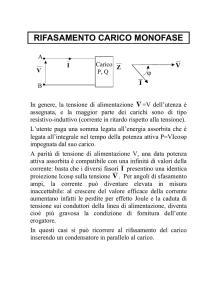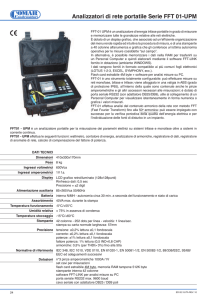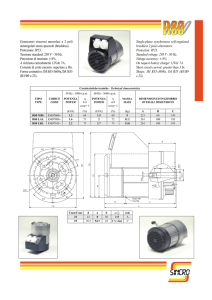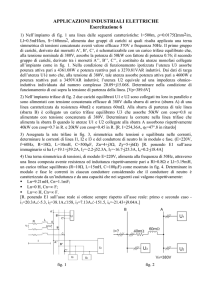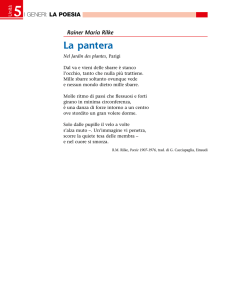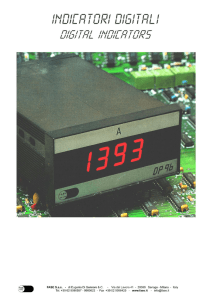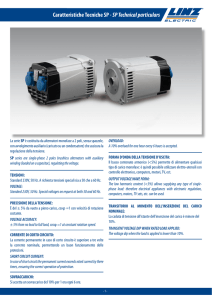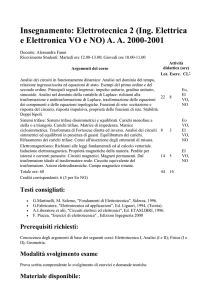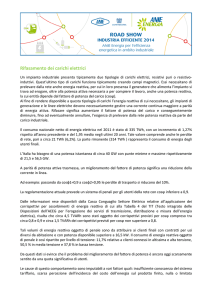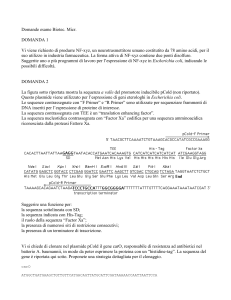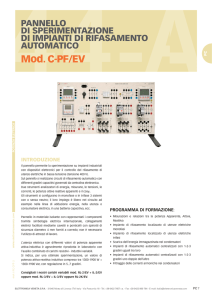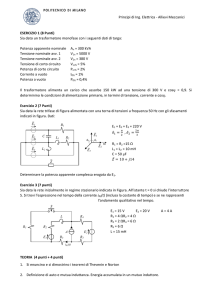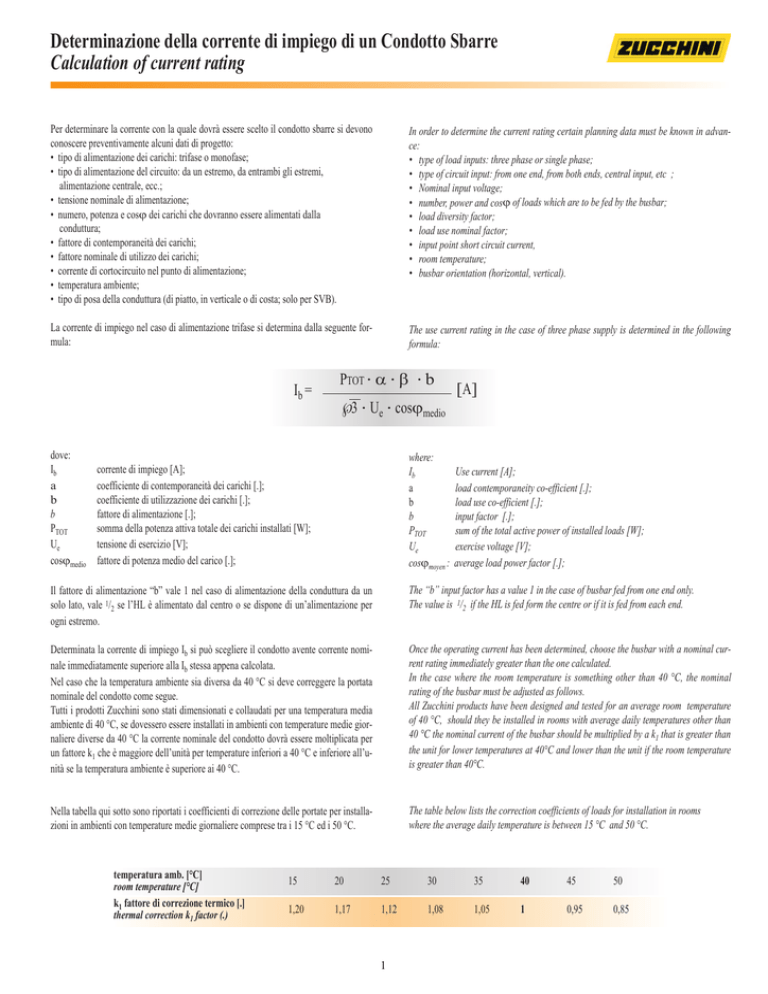
Determinazione della corrente di impiego di un Condotto Sbarre
Calculation of current rating
Per determinare la corrente con la quale dovrà essere scelto il condotto sbarre si devono
conoscere preventivamente alcuni dati di progetto:
• tipo di alimentazione dei carichi: trifase o monofase;
• tipo di alimentazione del circuito: da un estremo, da entrambi gli estremi,
alimentazione centrale, ecc.;
• tensione nominale di alimentazione;
• numero, potenza e cosϕ dei carichi che dovranno essere alimentati dalla
conduttura;
• fattore di contemporaneità dei carichi;
• fattore nominale di utilizzo dei carichi;
• corrente di cortocircuito nel punto di alimentazione;
• temperatura ambiente;
• tipo di posa della conduttura (di piatto, in verticale o di costa; solo per SVB).
In order to determine the current rating certain planning data must be known in advance:
• type of load inputs: three phase or single phase;
• type of circuit input: from one end, from both ends, central input, etc ;
• Nominal input voltage;
• number, power and cosϕ of loads which are to be fed by the busbar;
• load diversity factor;
• load use nominal factor;
• input point short circuit current,
• room temperature;
• busbar orientation (horizontal, vertical).
La corrente di impiego nel caso di alimentazione trifase si determina dalla seguente formula:
The use current rating in the case of three phase supply is determined in the following
formula:
Ib =
PTOT • α • β • b
√ 3 Ue cosϕmedio
•
dove:
Ib
a
b
b
PTOT
Ue
cosϕmedio
[A]
•
where:
Ib
a
b
b
PTOT
Ue
cosϕmoyen :
corrente di impiego [A];
coefficiente di contemporaneità dei carichi [.];
coefficiente di utilizzazione dei carichi [.];
fattore di alimentazione [.];
somma della potenza attiva totale dei carichi installati [W];
tensione di esercizio [V];
fattore di potenza medio del carico [.];
Use current [A];
load contemporaneity co-efficient [.];
load use co-efficient [.];
input factor [.];
sum of the total active power of installed loads [W];
exercise voltage [V];
average load power factor [.];
Il fattore di alimentazione “b” vale 1 nel caso di alimentazione della conduttura da un
solo lato, vale 1/2 se l’HL è alimentato dal centro o se dispone di un’alimentazione per
ogni estremo.
The “b” input factor has a value 1 in the case of busbar fed from one end only.
The value is 1/2 if the HL is fed form the centre or if it is fed from each end.
Determinata la corrente di impiego Ib si può scegliere il condotto avente corrente nominale immediatamente superiore alla Ib stessa appena calcolata.
Nel caso che la temperatura ambiente sia diversa da 40 °C si deve correggere la portata
nominale del condotto come segue.
Tutti i prodotti Zucchini sono stati dimensionati e collaudati per una temperatura media
ambiente di 40 °C, se dovessero essere installati in ambienti con temperature medie giornaliere diverse da 40 °C la corrente nominale del condotto dovrà essere moltiplicata per
un fattore k1 che è maggiore dell’unità per temperature inferiori a 40 °C e inferiore all’unità se la temperatura ambiente è superiore ai 40 °C.
Once the operating current has been determined, choose the busbar with a nominal current rating immediately greater than the one calculated.
In the case where the room temperature is something other than 40 °C, the nominal
rating of the busbar must be adjusted as follows.
All Zucchini products have been designed and tested for an average room temperature
of 40 °C, should they be installed in rooms with average daily temperatures other than
40 °C the nominal current of the busbar should be multiplied by a k1 that is greater than
the unit for lower temperatures at 40°C and lower than the unit if the room temperature
is greater than 40°C.
Nella tabella qui sotto sono riportati i coefficienti di correzione delle portate per installazioni in ambienti con temperature medie giornaliere comprese tra i 15 °C ed i 50 °C.
The table below lists the correction coefficients of loads for installation in rooms
where the average daily temperature is between 15 °C and 50 °C.
temperatura amb. [°C]
room temperature [°C]
k1 fattore di correzione termico [.]
thermal correction k1 factor (.)
15
20
25
30
35
40
45
50
1,20
1,17
1,12
1,08
1,05
1
0,95
0,85
1
In conclusione per la scelta della blindosbarra dovrà essere verificata la seguente relazione:
Finally, the following should be considered for the most appropriate busbar choice:
Int ≥ Ib
Int = k1 In
•
dove Int è la corrente che la conduttura può portare per un tempo indefinito alla temperatura ambiente specificata.
where Int stands as maximum current loaded by a busbar for an indefinite time at the
environmental specified temperature.
Caduta di tensione
Se lo sviluppo di una linea è particolarmente lungo è necessario fare una verifica della
caduta di tensione (in seguito indicata con c.d.t.). Per linee esercite con un sistema trifase e con fattore di potenza (cosϕ) non inferiore a 0.8, la c.d.t. trifase si può calcolare con
la formula semplificata:
Voltage drop
If the length of the run is particularly long it is necessary to check the voltage drop (vd).
For installations with a three phase system and a power factor (cosϕ) not lower than
0.8 the three phase vd may be calculated with the following simplified formula.
∆V = a • √ 3 • Ib • L • ( Rt • cosϕ + X • senϕ) • 10-3 [V]
dove:
a
Ib
L
Rt
where:
a
Ib
L
Rt
fattore di distribuzione della corrente [.]
corrente di impiego [A]
lunghezza del condotto [m]
resistenza di fase per unità di lunghezza del blindo misurata
a regime termico* [mΩ/m]
X
reattanza di fase per unità di lunghezza del blindo [mΩ/m]
fattore di potenza medio del carico
cosϕ
senϕ = √(1- cos2ϕ)
X
cosϕ
sinϕ =
current distribution factor[.]
use current [A]
duct length [m]
phase resistance per unit length of the bus-duct measured in
thermal regime[mΩ/m]
phase resistance per unit length of bus-duct [mΩ/m]
average load power factor
√(1- cos2ϕ)
* le Norme impongono che per condutture con valori di portata superiori a 630 A vengano riportati i valori di resistenza di
* The regulation state that busbars with load values exceeding 630 A must indicate the thermal regime phase resistance
fase a regime termico misurati durante la prova di riscaldamento a corrente nominale e temperatura ambiente di + 20 °C.
values measured during the nominal current heating tests and room temperature of + 20C
Nel caso di c.d.t. monofase la relazione che lega i vari fattori non varia sostanzialmente.
∆V = a • Ib • L • ( 2 • Rt • cosϕ + 2 • X • senϕ) • 10-3 [V]
Il fattore di distribuzione della corrente “a” dipende da come viene alimentato il circuito
e dalla disposizione dei carichi elettrici lungo il sistema sbarre:
Tipo di alimentazione e disposizione dei carichi
Type of input and load availability
The current distribution factor “a” depends on how the circuit is fed and the
distribution of the loads along the busbar.
“a” fattore di distribuzione della corrente
“a” current distribution factor
alimentazioni da un solo estremo con carico concentrato alla fine
Input from one end only with load concentrated at one end
1
alimentazioni da un solo estremo con carico uniformemente distribuito
Input from one end only with uniform load distribution
alimentazione da entrambi gli estremi con carico uniform. distribuito
Input from both end with uniform load distribution
alimentazione centrale con carichi concentrati agli estremi
Central input with load concentrated at the ends
alimentazione centrale con carico uniformemente distribuito
Central input with load uniformly distributed
0.5
0.25
0.25
0.125
2
Short circuit current
The nominal short circuit current value which the Super Compact can withstand makes
provision for both electrodynamic stress and thermal energy dissipated during the fault.
The busbar must be able to sustain the short circuit current for the entire duration of the
fault i.e for the time required for the protection device to intervene, cutting off the metal
continuity and extinguishing the electric arch. The electrodynamic stresses are directly
proportional to the product of the instant current value which affect the line and is not
proportional to the distance of the bars.
The assumed peak current ( Ipk) may be determined by starting from the effective value
of the short circuit current (ICW) at the incoming point and multiplying by the “n” factor
included in the table below (extract from pg 26 of the CEI 17-13/1 regulations:
Corrente di corto circuito
Il valore della corrente di corto circuito nominale che i nostri condotti sbarre sopportano
tiene conto sia degli sforzi elettrodinamici che dell’energia termica dissipata durante il
guasto.
Le sbarre devono essere in grado di sopportare la corrente di corto circuito per tutto il
perdurare del fenomeno cioè per il tempo impiegato dal dispositivo di protezione ad
intervenire, interrompere la continuità metallica ed estinguere l’arco elettrico.
La corrente di picco presunta di un impianto elettrico (Ipk) si può determinare conoscendo il valore efficace della corrente di corto circuito (ICW) e moltiplicandolo per i fattori
“n” inclusi nella tabella sottostante (estratta dalla pg. 26 della norma CEI 17-13/1)
Valore efficace della corrente di corto circuito
Effective value of the short circuit current
I ≤ 5 kA
5 kA < I ≤ 10 kA
10 kA < I < 20 kA
20 kA < I ≤ 50 kA
I > 50 kA
cos Φ
n = Ipk / I
0.7
0.5
0.3
0.25
0.2
1.5
1.7
2
2.1
2.2
Losses due to Joule effect
Losses due to the Joule effect are essentially due to the electrical resistance of the
busbar. Lost energy is transformed into heat and contributes to the heating of the bars.
In the three phase system the losses are assessed with the ratio.
Perdite per effetto Joule
Le perdite per effetto Joule sono dovute alla resistenza elettrica del condotto sbarre.
L’energia persa viene trasformata in calore e contribuisce al riscaldamento della conduttura. Le perdite contribuiscono anche ad abbassare il rendimento della trasmissione di
energia.
In regime trifase le perdite sono valutabili con la relazione
P = 3 Rt I2 10-3[W/m]
•
•
•
While in the single-phase system.
Mentre in regime monofase
P = 2 Rt I2 10-3 [W/m]
•
•
3
•

